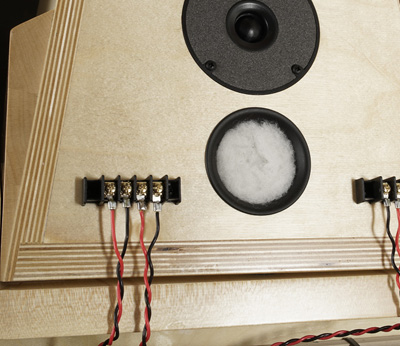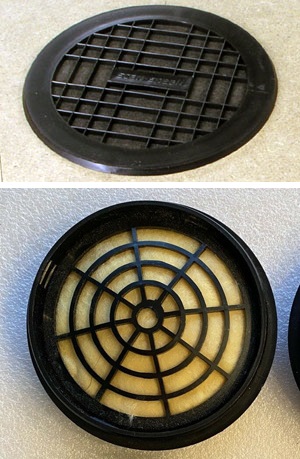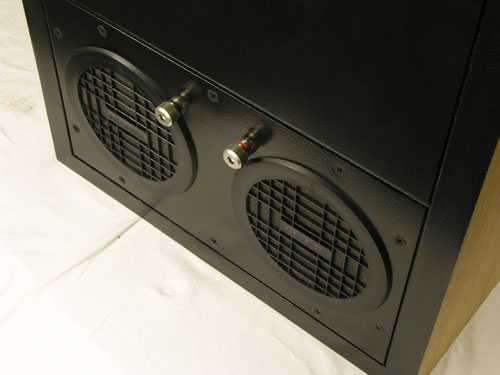Acoustic vent,
Variovent
Copyright 2020 © Troels Gravesen
What is an acoustic vent and aperiodic tuning?



The Variovent seen above is from my
re-creation of the JBL L100, 2008.
To the left the stuffed port of my
Ellipticor-4 midrange cabinet.
The Variovent is out of production but you can still get the same thing from using a conventional port and stuff it lightly with acoustilux. I suggest a 68 x 200 mm port (Jantzen Audio). Cut it to 10 cm length. Now, the question is how much acoustilux should be added? I suggest for a start rolling a 10 x 20 cm piece of 30 mm acoustilux at insert it into the port. If you can do an impedance plot you add damping material until you get the same impedance profile as can be seen below. If you cannot perform measurements, you have to tune by ear. No damping will make a boomy bass peaking 4 dB at 63 Hz from a 65 litre cabinet and Fb = 30 Hz. Stuffing the port really hard (closed box) will reduce the bump by 2 dB. The full length - non-stuffed - port (20 cm) will make a Fb = 22 Hz. Try it out.
The Variovent consists of two grilles with some damping material stuck in between. Simple as that. The diameter, amount of damping material and the compression of the material determines the air flow properties = acoustic resistance. The late Gilbert Briggs (Wharfedale) made slits in the rear panel and added damping material over the slits. Works the same and costs nothing. But you have to be able to follow the impedance of the system to tune the amount of damping material needed.
The Variovent is a device sometimes causing much debate. What is an acoustic vent? Well, an acoustic vent allows some ventilation at low frequences and virtually none at higher frequences. So what's that supposed to be good for? Neville Thiele studied the Variovent in detail and concluded it didn't offer any advantage over a properly designed vented systems. The general advice on the use of acoustic vents is simple: Try it! Which offers little comfort to those addicted to math. But box calculation based on Thiele/Small data really only apply for speakers with a Qt = 0.35, which only counts for very few drivers. Based on experience we use speakers with high Qt in cabs too small and drivers with low Qt in cabs too large compared to strict box simulation.
Comparing the impedance peaks of a driver in free air and a perfectly closed and empty box should reveal the same peak height, so we have no loss in the closed box. Obviously the resonance frequency is higher. Adding damping material to the closed box we see a decline in peak height; now we have some loss. Adding an acoustic vent may produce a significant reduction in peak height depending on how open the vent is. So, the system Q-value is lowered (= more loss) from applying an acoustic vent although we really can't speak of a Q-value of an aperiodic system. Basically a closed box has 2nd order roll-off, a vented system a 4th order roll-off and the aperiodic system a 3rd order roll-off.
The Variovent was often used in the 70'ies and 80'ies by ScanSpeak and not least Dynaudio.